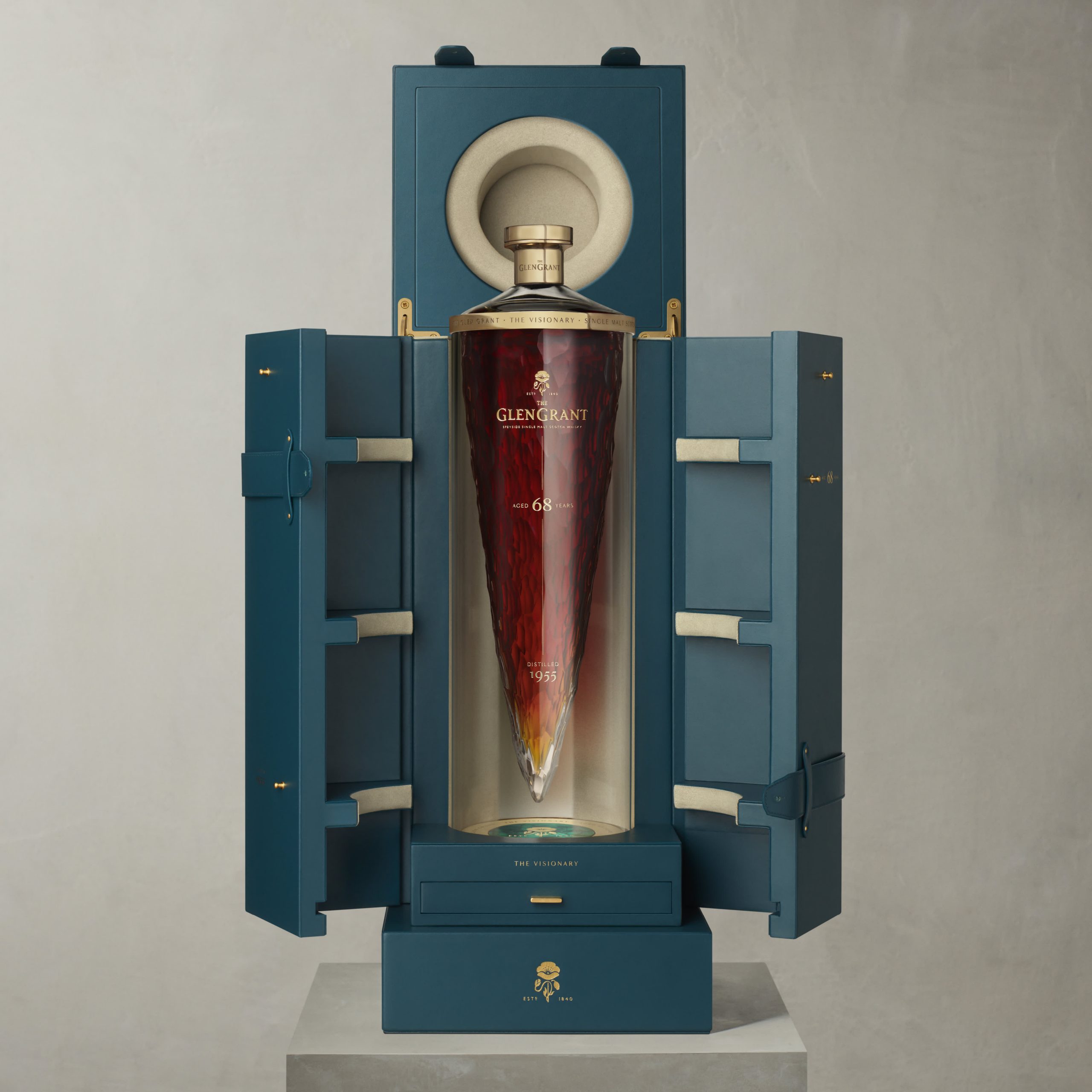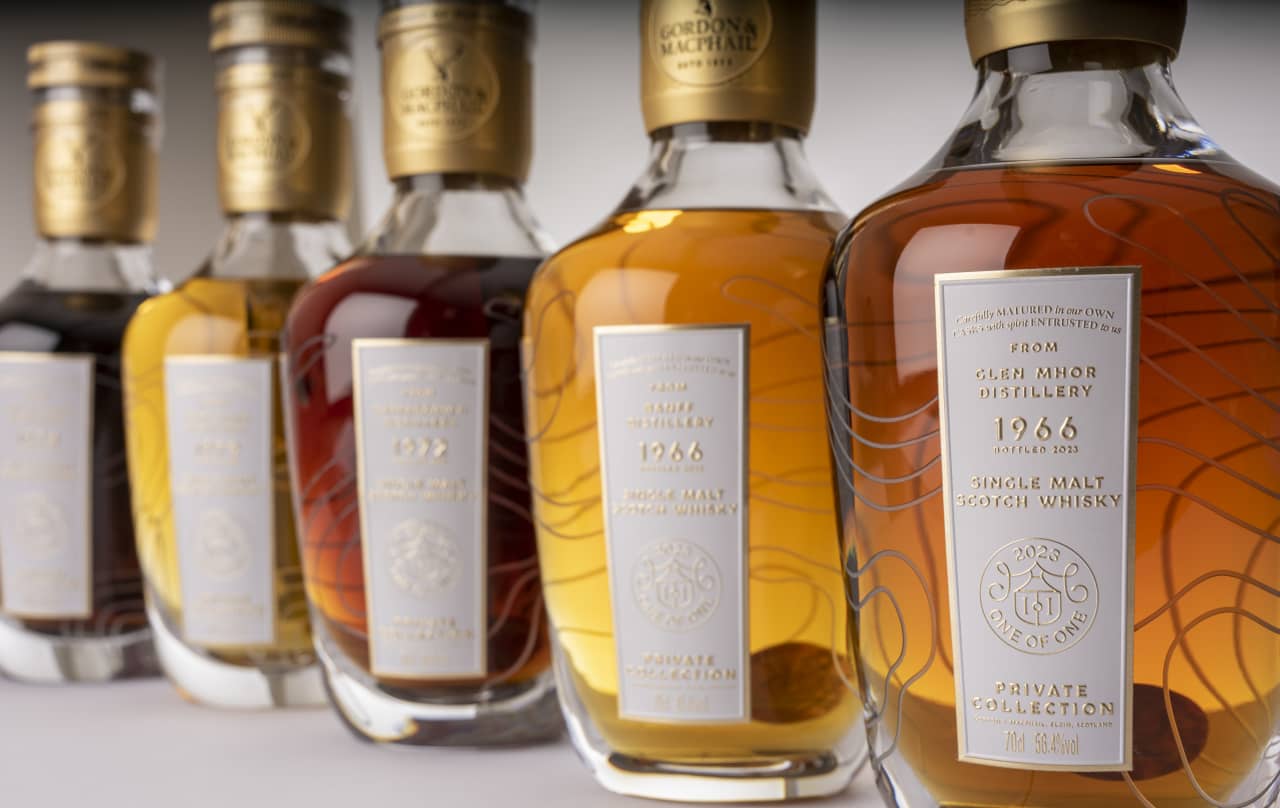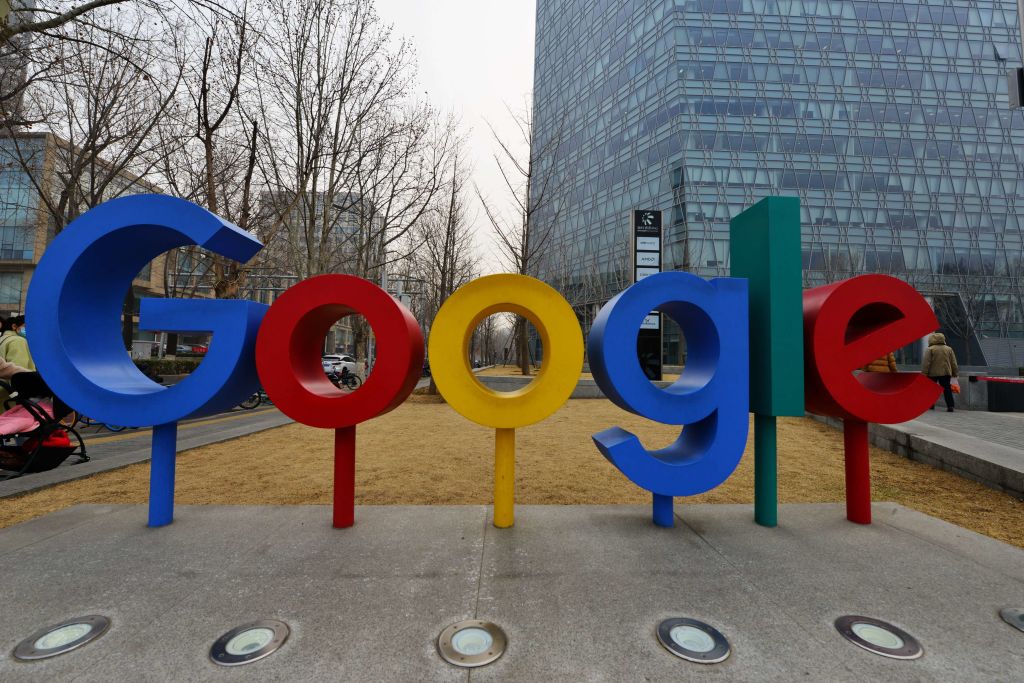An ultra-rare whisky auction, known as the Distillers One of One, has announced its second edition will take place next month at Hopetoun House on the outskirts of Edinburgh, Scotland.
In partnership with Sotheby’s, the auction brings together a collection of one-off Scotch whiskies specially created and donated by leading distilleries across Scotland.
Headlining the sale is the highest valued lot, Bowmore STAC 55 Years Old, the oldest whisky the island distillery’s ever produced. It’s housed in a 1.5-litre hand-blown glass vessel that pays homage to Bowmore’s home on the island of Islay. The lot is estimated to sell for between £300,000 and £500,000 (roughly between US$371,900 and US$619,770).
The auction “represents all of the best elements of this industry: the community spirit, the rarity of the liquid, the creativity of the presentation, and, above all, the charitable nature,” says Jonny Fowle, global head of spirits at Sotheby’s.

Courtesy of Sotheby’s
Also of note is the 50-year-old Brora Iris (with an estimate between £200,000 and £400,000), the oldest Brora single malt that has ever been bottled and one that will never be made commercially available. The liquid is presented in a 1.5-litre decanter that’s suspended within a handcrafted stone sculpture. The bottle was designed to represent the eye of a Scottish Wildcat, the highly elusive native of the Scottish Highlands that is the emblem of the distillery.
Proceeds of the auction will be donated to the Distillers’ Charity, principally to the Youth Action Fund, which aims to improve the lives of disadvantaged young people in Scotch whisky-making communities.
The first Distillers One of One was held at Barnbougle Castle, also near Edinburgh, in December 2021. That auction featured more than 39 lots and achieved record-breaking hammer prices, with more than £2.4 million donated to The Distillers’ Charity.
“The success of the first auction was tremendous—the vision and work put in by the Distillers’ Charity supported by the contributions from the Scotch whisky industry has established a new force in Scotland to back our young people in extremely difficult times,” John Swinney, former deputy first minister of Scotland, said in the catalog notes.
Scheduled for Oct. 5, the auction—a ticketed event for which all attendees must be registered—will feature 39 lots with estimates ranging from £2,000 to £500,000. Collectors can place online bids in advance; a selection of lots is currently on view in Sotheby’s New Bond Street galleries in London through Sept. 20.
The entire operation is dependent on the generosity of some of the most revered brands in the field, with producers both new and old presenting exceptional whiskies, all in the name of charity. In addition to the rare bottles, casks and experiences donated for sale, the brands also provide support to make the event possible.

Courtesy of Sotheby’s
Other offerings at the sale include the Visionary (with an estimate between £50,000 and £90,000), a single malt that has been aged 68 years, making it one of the oldest whiskies to be released by Speyside’s historic Glen Grant Distillery.
Another unique item for sale is the Gordon & MacPhail Recollection Showcase (with an estimate between £80,000 and £160,000). Housed in a handcrafted cabinet made of elm and oak, the offering features five engraved Glencairn decanters. Each contains a one-off 70-cl single malt from five distilleries that have been lost or silent for decades.
“A wiser man than me described this as being ‘the whisky olympics,’ Fowle says. “I cannot wait to be on the rostrum for this auction and see how we can develop this project into 2025.”
 Copyright 2020, Dow Jones & Company, Inc. All Rights Reserved Worldwide. LEARN MORE
Copyright 2020, Dow Jones & Company, Inc. All Rights Reserved Worldwide. LEARN MORE
What a quarter-million dollars gets you in the western capital.
Alexandre de Betak and his wife are focusing on their most personal project yet.
CIOs can take steps now to reduce risks associated with today’s IT landscape
As tech leaders race to bring Windows systems back online after Friday’s software update by cybersecurity company CrowdStrike crashed around 8.5 million machines worldwide, experts share with CIO Journal their takeaways for preparing for the next major information technology outage.
Be familiar with how vendors develop, test and release their software
IT leaders should hold vendors deeply integrated within IT systems, such as CrowdStrike , to a “very high standard” of development, release quality and assurance, said Neil MacDonald , a Gartner vice president.
“Any security vendor has a responsibility to do extensive regression testing on all versions of Windows before an update is rolled out,” he said.
That involves asking existing vendors to explain how they write software, what testing they do and whether customers may choose how quickly to roll out an update.
“Incidents like this remind all of us in the CIO community of the importance of ensuring availability, reliability and security by prioritizing guardrails such as deployment and testing procedures and practices,” said Amy Farrow, chief information officer of IT automation and security company Infoblox.
Re-evaluate how your firm accepts software updates from ‘trusted’ vendors
While automatically accepting software updates has become the norm—and a recommended security practice—the CrowdStrike outage is a reminder to take a pause, some CIOs said.
“We still should be doing the full testing of packages and upgrades and new features,” said Paul Davis, a field chief information security officer at software development platform maker JFrog . undefined undefined Though it’s not feasible to test every update, especially for as many as hundreds of software vendors, Davis said he makes it a priority to test software patches according to their potential severity and size.
Automation, and maybe even artificial intelligence-based IT tools, can help.
“Humans are not very good at catching errors in thousands of lines of code,” said Jack Hidary, chief executive of AI and quantum company SandboxAQ. “We need AI trained to look for the interdependence of new software updates with the existing stack of software.”
Develop a disaster recovery plan
An incident rendering Windows computers unusable is similar to a natural disaster with systems knocked offline, said Gartner’s MacDonald. That’s why businesses should consider natural disaster recovery plans for maintaining the resiliency of their operations.
One way to do that is to set up a “clean room,” or an environment isolated from other systems, to use to bring critical systems back online, according to Chirag Mehta, a cybersecurity analyst at Constellation Research.
Businesses should also hold tabletop exercises to simulate risk scenarios, including IT outages and potential cyber threats, Mehta said.
Companies that back up data regularly were likely less impacted by the CrowdStrike outage, according to Victor Zyamzin, chief business officer of security company Qrator Labs. “Another suggestion for companies, and we’ve been saying that again and again for decades, is that you should have some backup procedure applied, running and regularly tested,” he said.
Review vendor and insurance contracts
For any vendor with a significant impact on company operations , MacDonald said companies can review their contracts and look for clauses indicating the vendors must provide reliable and stable software.
“That’s where you may have an advantage to say, if an update causes an outage, is there a clause in the contract that would cover that?” he said.
If it doesn’t, tech leaders can aim to negotiate a discount serving as a form of compensation at renewal time, MacDonald added.
The outage also highlights the importance of insurance in providing companies with bottom-line protection against cyber risks, said Peter Halprin, a partner with law firm Haynes Boone focused on cyber insurance.
This coverage can include protection against business income losses, such as those associated with an outage, whether caused by the insured company or a service provider, Halprin said.
Weigh the advantages and disadvantages of the various platforms
The CrowdStrike update affected only devices running Microsoft Windows-based systems , prompting fresh questions over whether enterprises should rely on Windows computers.
CrowdStrike runs on Windows devices through access to the kernel, the part of an operating system containing a computer’s core functions. That’s not the same for Apple ’s Mac operating system and Linux, which don’t allow the same level of access, said Mehta.
Some businesses have converted to Chromebooks , simple laptops developed by Alphabet -owned Google that run on the Chrome operating system . “Not all of them require deeper access to things,” Mehta said. “What are you doing on your laptop that actually requires Windows?”















